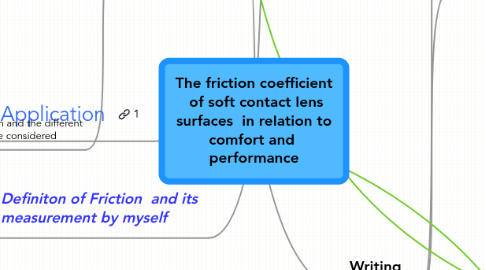
1. Click for Ethics Application
2. Definiton of Friction and its measurement by myself
2.1. Infinite friction
2.1.1. Also named static friction
2.1.2. no movement
2.2. zero friction
2.2.1. no friction at all
2.3. Between zero friction which only is theorically possible and infinite friction, which is known as static friction any numbering could be used
2.3.1. For calculation purposes influencing facturs like surface quality, exposed area forces and others need to be considered
3. In Vitro Testing
3.1. In Vitro apparatus 3 choices
3.1.1. M. Port's "Balance type" Apparatus
3.1.1.1. Seems to be easier to produce
3.1.1.2. Probably no differenciation between momentum and friction
3.1.1.2.1. It is questionable if a differentiation plays a role
3.1.1.3. Toni's "Rotating type" Apparatus
3.1.1.3.1. Perhaps more effort to produce
3.1.1.3.2. Probably a differentiation between momentum and friction can be observed
3.1.1.3.3. Disatvantage: Rotation causes indefinite variations of circular speed between zero in the middle and the max at the edge!
3.1.2. Microtribometer tests carried out with CL found in the literature only consider the lens surface under wet and dry conditions but do not consider the eye and the adnexes.
3.1.3. Third alternative: a ball of hydrophilic material, containing an axis to turn the ball which would enable a kind of a screenwasher effect which is closer to the eyelid movement but only moves over one rotational axis.
3.1.3.1. Would require one ball made out of material to simulate effects on the outer surfacd
3.1.3.2. Would require another ball made of some plastic material which mimic the corneal surface, while a semi finished blank consisting of a base curve simulates the base curve of the lens
3.2. Tear composition and the different layers have to be considered
3.2.1. is the lens surrounded by the aquaeus only?
4. Writing
4.1. Abstract
4.2. Introduction
4.2.1. Friction
4.2.1.1. Subtopics to be amended
4.2.1.2. Tribology
4.2.1.3. Biotribology
4.2.1.3.1. Hip replacements
4.2.1.3.2. Ocular tribology
4.2.2. The Eye
4.2.2.1. Cornea
4.2.2.2. Tears
4.2.2.3. Blinking
4.2.2.4. Lid Tension
4.2.2.5. Other subtopcis to be amended
4.2.3. Contact Lenses
4.2.3.1. History
4.2.3.2. Types
4.2.3.2.1. Soft
4.2.3.2.2. RGP
4.2.3.3. Fitting soft lenses
4.2.3.3.1. Criteria
4.2.3.3.2. Physiological fitting problems
4.2.3.3.3. Remedies
4.3. Method and Materials
4.3.1. In vitro
4.3.1.1. How about measuring radii changes due to temperature raise from room to 32 Celsius?
4.3.1.1.1. recent work carried out by myself shows extreme variations between materials
4.3.1.2. Test with tribometer to be developed and made.
4.3.1.3. Use ISO Saline standardized instead of reinventing artificial tears
4.3.2. In vivo
4.3.2.1. Check for initial fit and change after 30 minutes
4.3.2.1.1. Retinoscopic reflex mus be bright and without keratoconus like phenomens.
4.3.2.1.2. compare Retinoscipy spot of POC withbest correction with and without lens. It must be the same.
4.3.2.1.3. Search for ring mark of lens on the conjunctiva (sign for steep fit)
4.4. Results
4.5. Discussion
4.6. Conclusions
4.7. References
4.7.1. Author
4.7.2. Title
4.7.3. Year
4.7.4. Volume No.
4.7.4.1. Page(s)
4.7.5. Publisher
5. Literature search
5.1. Questions arised
5.1.1. Lid pressure how to measure
5.1.1.1. Would a test with tweezers and something like a spring balance solve unproven hypotheses?
5.1.2. Lid pressure in the literature
5.1.2.1. Only 2 relevant publications found yet
5.2. Rheology
5.2.1. Regard Tear Film rupture
5.2.1.1. Fatt's model
5.2.1.2. Holly's model
5.2.2. How does the moucous produced by Goblet cells penetrate through the aqueous layer and builds up moucous layer between the microvilli?
5.2.3. Van der Waals law
5.2.4. Newtons liquid
5.2.5. Liquid surface and friction
5.2.6. Adhesive forces
